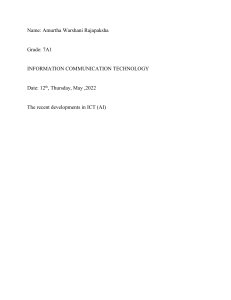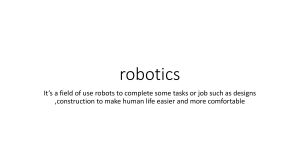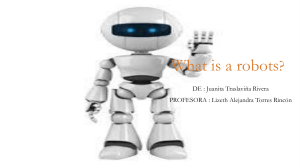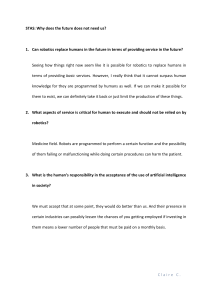Industrial Robotics Market Is Predicted to Gain USD 142.8 Billion at 11.4% CAGR by 2032, States Market.us
advertisement
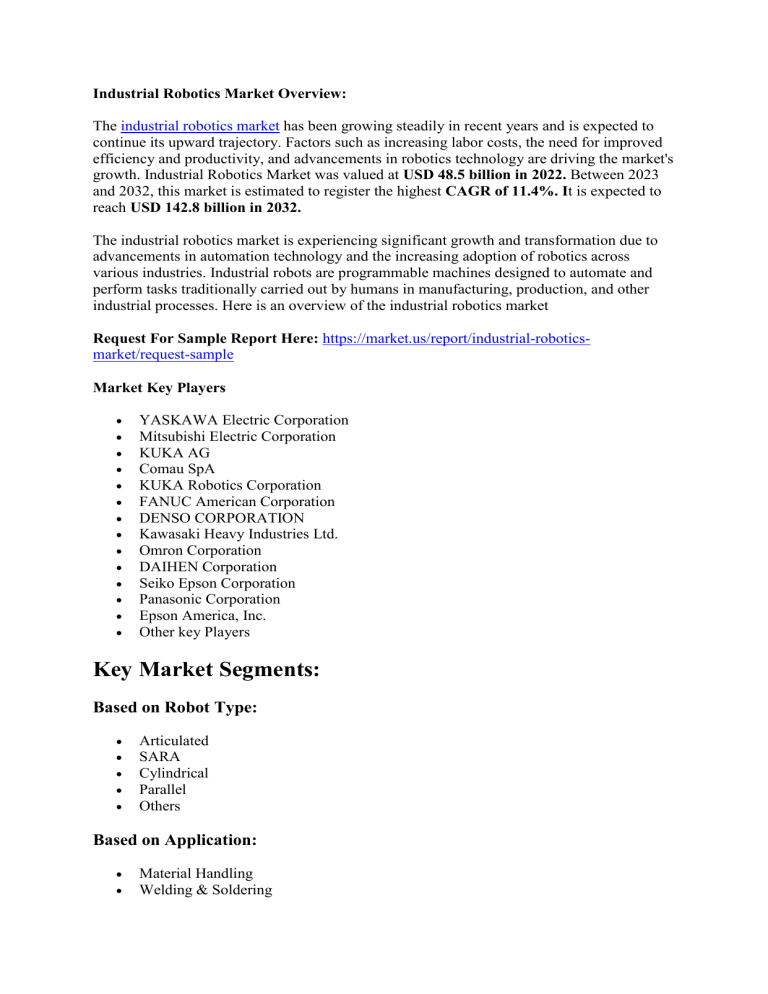
Industrial Robotics Market Overview: The industrial robotics market has been growing steadily in recent years and is expected to continue its upward trajectory. Factors such as increasing labor costs, the need for improved efficiency and productivity, and advancements in robotics technology are driving the market's growth. Industrial Robotics Market was valued at USD 48.5 billion in 2022. Between 2023 and 2032, this market is estimated to register the highest CAGR of 11.4%. It is expected to reach USD 142.8 billion in 2032. The industrial robotics market is experiencing significant growth and transformation due to advancements in automation technology and the increasing adoption of robotics across various industries. Industrial robots are programmable machines designed to automate and perform tasks traditionally carried out by humans in manufacturing, production, and other industrial processes. Here is an overview of the industrial robotics market Request For Sample Report Here: https://market.us/report/industrial-roboticsmarket/request-sample Market Key Players YASKAWA Electric Corporation Mitsubishi Electric Corporation KUKA AG Comau SpA KUKA Robotics Corporation FANUC American Corporation DENSO CORPORATION Kawasaki Heavy Industries Ltd. Omron Corporation DAIHEN Corporation Seiko Epson Corporation Panasonic Corporation Epson America, Inc. Other key Players Key Market Segments: Based on Robot Type: Articulated SARA Cylindrical Parallel Others Based on Application: Material Handling Welding & Soldering Assembling & Disassembling Palletizing, Packaging Painting & Dispensing Milling Others Based on End-Use Industry: Automotive Electrical & Electronics Aerospace & Defense Chemicals Food & Beverages Healthcare & Pharmaceuticals Others For details on other major vendors and their offerings - Buy the report at: https://market.us/purchase-report/?report_id=55415 Drivers of the Industrial Robotics Market: 1. Increasing Need for Automation: The need to enhance operational efficiency, productivity, and quality control is driving the adoption of industrial robots across industries. 2. Cost and Labor Savings: Industrial robots offer long-term cost savings by reducing labor costs, minimizing errors, and improving production throughput. 3. Advancements in Robotics Technology: Technological advancements, such as improved sensors, machine vision, artificial intelligence, and collaborative capabilities, are expanding the capabilities and applications of industrial robots. 4. Industry 4.0 and Smart Manufacturing: The integration of industrial robots with technologies like IoT, cloud computing, and big data analytics is driving the adoption of robots in smart factories and the implementation of Industry 4.0 concepts. 5. Safety and Workforce Concerns: Industrial robots can perform hazardous and repetitive tasks, mitigating safety risks for workers and addressing labor shortage challenges. Restraints of the Industrial Robotics Market: 1. High Initial Investment: The upfront cost of acquiring and integrating industrial robots can be substantial, particularly for small and medium-sized enterprises, hindering widespread adoption. 2. Complexity of Integration: Integrating robots into existing manufacturing systems can be complex and require specialized expertise, which can be a challenge for companies with limited technical resources. 3. Lack of Skilled Workforce: Operating and programming industrial robots requires skilled technicians and engineers, and the shortage of such talent can limit the adoption of robotics in certain regions or industries. 4. Potential Job Displacement Concerns: The automation of certain tasks through industrial robots raises concerns about job displacement and requires careful management and workforce reskilling efforts. Opportunities in the Industrial Robotics Market: 1. Small and Medium-Sized Enterprises (SMEs): There is a significant opportunity for industrial robots in SMEs as the cost of robots decreases, and user-friendly, plugand-play solutions become more prevalent. 2. Service Robotics: The market for service robots, including robots for healthcare, logistics, and personal assistance, is growing, presenting new avenues for industrial robotics companies. 3. Emerging Markets: The adoption of industrial robots is increasing in emerging markets with growing manufacturing sectors, such as China, India, and Southeast Asian countries, offering substantial growth opportunities. 4. Customization and Flexibility: Industrial robots that can be easily programmed and reconfigured for different tasks and industries have potential in applications requiring customization and flexibility. Ensure everything is in line with your specific requirements here: https://market.us/report/industrial-robotics-market/#inquiry Recent Trends in the Dry Eye Syndrome Market: 1. Collaborative Robotics: The rise of collaborative robots, or cobots, designed to work safely alongside humans, has gained momentum, enabling new applications and expanding the user base. 2. Artificial Intelligence and Machine Learning Integration: Industrial robots are increasingly being equipped with AI and machine learning capabilities for enhanced decision-making, autonomous operation, and adaptive learning. 3. Mobile and Autonomous Robots: Mobile robots, including autonomous mobile robots (AMRs) and autonomous guided vehicles (AGVs), are being deployed for material handling, logistics, and warehouse automation. 4. Human-Robot Collaboration: Emphasis is being placed on developing intuitive human-robot interfaces, communication methods, and safety mechanisms to enable seamless collaboration between humans and robots. 5. Advanced Sensing and Vision Systems: Industrial robots are incorporating advanced sensors, 3D vision systems, and machine vision algorithms to improve object recognition, quality control, and adaptability. Advantages of Industrial Robotics: Industrial robots offer numerous benefits to businesses, including increased productivity, improved product quality, enhanced workplace safety, and reduced operational costs. Robots can work continuously without fatigue, perform repetitive tasks with high accuracy, and handle heavy loads, resulting in improved overall efficiency and output. Collaborative Robotics: Collaborative robots, or cobots, are a significant trend in the industrial robotics market. These robots are designed to work alongside humans, sharing the workspace and collaborating on tasks. Cobots are equipped with advanced sensors and safety features that enable safe human-robot interaction, making them suitable for tasks that require close collaboration and flexibility. Regional Market Dynamics: The industrial robotics market is witnessing growth across various regions. Asia-Pacific, particularly China, has emerged as a dominant market due to its robust manufacturing sector and government initiatives to promote automation. North America and Europe are also significant markets, driven by technological advancements, the adoption of Industry 4.0 concepts, and the need for advanced manufacturing processes. Challenges and Future Outlook: While the industrial robotics market is thriving, there are challenges that need to be addressed, including the high initial investment cost, complex integration processes, and concerns related to job displacement. However, as technology continues to advance, robots are becoming more affordable, easier to program, and adaptable to diverse applications. Contact Global Business Development Team – Market.us Market.us (Powered by Prudour Pvt. Ltd.) Send Email: inquiry@market.us Address: 420 Lexington Avenue, Suite 300 New York City, NY 10170, United States Tel: +1 718 618 4351 Website: https://market.us/
